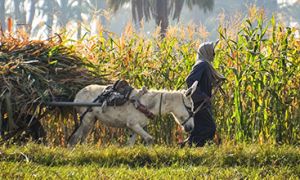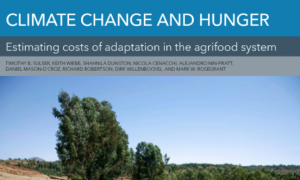Research since the 1990s highlights the importance of tenure rights for sustainable natural resource management, and for alleviating poverty and enhancing nutrition and food security for the 3.14 billion rural inhabitants of less-developed countries who rely on forests and agriculture for their livelihoods
Search
As the 2022 Global Hunger Index (GHI) shows, the global hunger situation is undeniably grim.
Gender relations shape women’s and men’s identities, norms, rules, and responsibilities. They influence people’s access to, use, and management of land and other natural resources, including ownership, tenure, and user rights to land and forests.
While agriculture has been resilient to the health crisis in comparison with the service and industry sectors, the sector's resiliency is gradually being corroded by climate change, with lasting, harmful effects for agriculture and food systems
Focusing on offsetting climate change impacts on hunger through investment in agricultural research, water management, and rural infrastructure in developing countries.
Ethiopia has made consistent progress in improving development indicators, but vulnerability to extreme weather events is a continuing concern, especially for people reliant on agriculture for their livelihoods.
The agriculture sector is key for economic and social development, but the sector’s potential has not received enough attention from policy makers and stakeholders in the Middle East and North Africa (MENA) region.
Understanding household preferences on the production, consumption, and sale of nutritious crops
Value chains and agricultural commercialization are increasingly promoted as mechanisms for agricultural transformation, inclusive growth, and, more recently, improved food security and diets.
Food and nutrition security implications of crop diversification in Malawi’s farm households
Although the Malawian food supply is shaped largely by trends in smallholder food crop production, Malawi’s decades-long focus on improving smallholder productivity has only moderately improved food security and nutrition outcomes.
2017 Global hunger index by severity
Note: For the 2017 GHI, data on the proportion of undernourished are for 2014–2016; data on child stunting and wasting are for the latest year in the period 2012–2016 for which data are available; and data on child mortality are for 2015.
Le rapport de l’Indice de la faim dans le monde 2017 (GHI) – douzième édition - propose une mesure multidimensionnelle de la faim au niveau national, régional et international.
Der Welthunger-Index (WHI) 2017 zeigt langfristige Fortschritte in der Reduzierung des Hungers in der Welt. Diese Fortschritte waren allerdings ungleich verteilt.
Der Welthunger-Index (WHI) 2017 ist der zwölfte in einer Reihe jährlicher Berichte, in denen die Hungersituation weltweit, nach Regionen, auf Länder- und auf nationaler Ebene mithilfe eines multidimensionalen Ansatzes dargestellt wird.
The 2017 Global Hunger Index (GHI) shows long-term progress in reducing hunger in the world.



